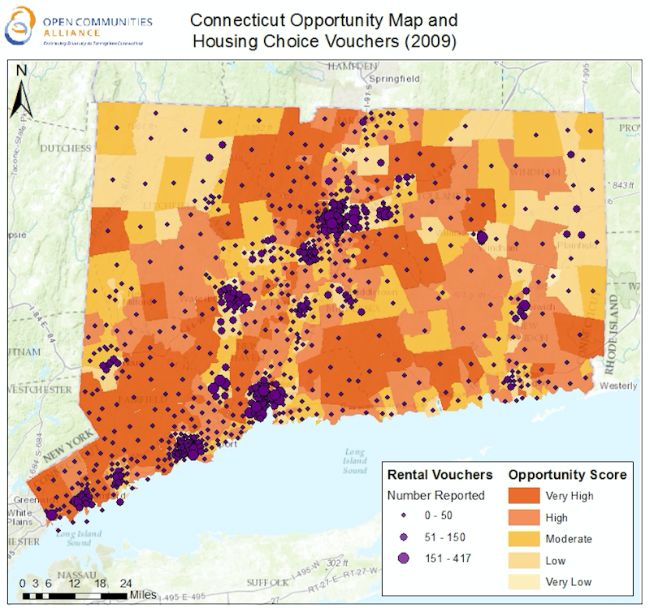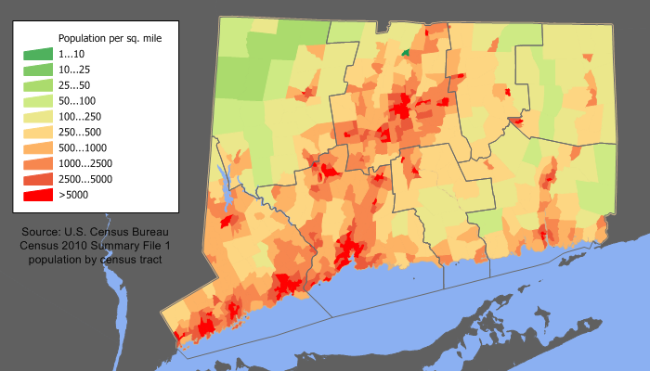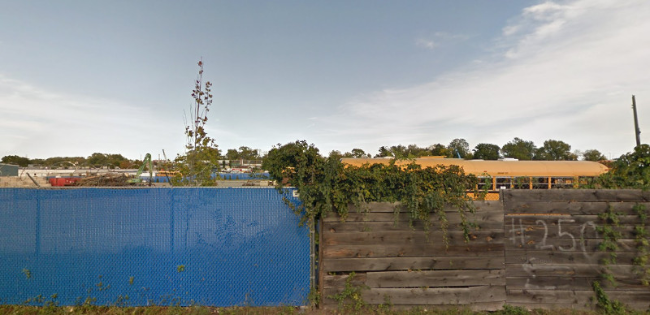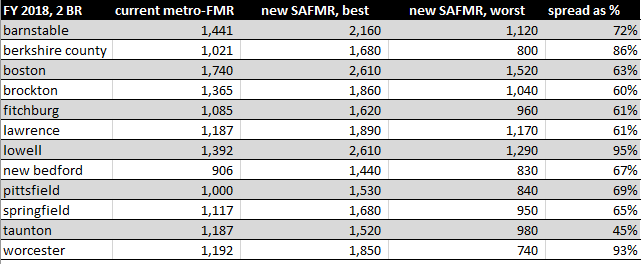HUD Loses Case to CT Nonprofit, Section 8 “Small Area” FMRs Roll Out
| . Posted in News - 0 Comments
On December 23, 2017, the Department of Housing and Urban Development (HUD) lost a lawsuit seeking to overturn HUD’s delay of “small area fair market rents” (SAFMR’s). Section 8 voucher holders in 23 metro regions (none in MA) will now have “fair market rent” set based on the specific zip code of the proposed residence. Landlords in those regions may see a 45% increase or decrease in allowable rents.
In OCA v Carson, the US District Court for the District of Columbia enjoined HUD to continue with its planned roll-out of small area fair market rents.
SAFMR History
The case traces back to 2000, when HUD concluded that fair market rents (FMR’s) calculated based on metro region averages were “not an effective tool” for “increasing [Housing Choice Voucher] HCV tenant moves from areas of low [economic] opportunity to higher opportunity areas.” Fair market rents were increased to median metro rents, but this did not help Section 8 voucher holders live outside areas of concentrated poverty.
In 2011, HUD started testing “small area fair market rents” (SAFMR’s), calculated by zip code instead of metro region. By November 16, 2016, HUD had completed public notice and regulatory process to issue a final ruling mandating SAFMR’s effective January 1, 2018 in 24 metro regions. The regions included New York, Chicago, Oakland, Dallas, and Philadelphia, but overall were a fraction of the regions HUD serves.
On August 10, 2017, HUD issued a memorandum delaying mandatory implementation of SAFMR’s for all 24 areas except Dallas. HUD’s primary concern was that the number of units removed from consideration in low-opportunity zip codes would not be replaced one-for-one with units in high-opportunity zip codes. In other words, SAFMR’s might reduce the number of landlords renting to Section 8. (Unlike in MA, landlords in many parts of the country can opt out of participating in Section 8.)
HUD cited two other factors. First, public housing authorities (PHA’s) were unable to be ready by January 1, 2018. Second, “related regulatory burden reduction and reform efforts” could make SAFMR’s or related guidance “become quickly outdated.”
HUD said SAFMR’s could still be adopted voluntarily.

The Open Communities Alliance graphic shows how Section 8 vouchers are disproportionately concentrated in areas of low economic opportunity. To filter out the correlation between voucher holders and population density, consider the CT population density graphic and compare the difference in voucher holders between green and orange regions. The orange regions should have far more voucher holders than the green regions; they do not. (The red regions will always be the densest.) With permission http://www.ctoca.org/oca_v_carson
OCA et al v Carson et al
The Open Communities Alliance, representing one renter in Connecticut, Crystal Carter, and one in Chicago, Tiara Moore, sued Ben Carson in his official capacity and the Department of Housing and Urban Development for an injunction. The United States District Court for the District Columbia agreed, issuing the injunction. In the decision, the court said HUD did not follow the same level of public rigor in delaying SAFMR’s as it did in mandating them.

Population density of Connecticut. CC-BY-SA Wikipedia - Jim Irwin.
The court found that HUD’s offer to let public housing authorities voluntarily use SAFMR’s failed to recognize a key finding of earlier studies showing that SAFMR’s would only work if all public housing authorities in a region participated. In the decision, “HUD’s counsel conceded at oral argument that no Rule-affected PHA had come forward to opt into the Rule voluntarily.”
In deciding the question of whether “irreparable harm” was present to merit the injunction, plaintiff Crystal Carter demonstrated a clear need to move out of Hartford, with 32.2% poverty rate, and to Simsbury, with 3.4% poverty rate, where her children attended school through the Harford’s Open Choice program.

This is the first print-resolution image from Google Maps of 06114, the current zip code of the plaintiff in OCA et al v Carson et al.

This is the first print-resolution image from Google Maps of Simsbury, the desired town of residence of the plaintiff in OCA et al v Carson et al.
Carter demonstrated that without the SAFMR, she could not afford Simsbury rent. She further demonstrated that not only would her children be closer to their school, in a safer neighborhood, with better opportunity to participate in extracurriculars, but also that her children were far likelier to succeed later in life having moved early to a better neighborhood. The court agreed with the studies on balance. “The weight of this research certainly indicates that Ms. Carter’s family may enjoy some additional benefits from living in Simsbury.”
Although HUD could never have been sued to create the SAFMR, once having created it, they would have to use equal rigor of process in stopping it. They did not. As of writing, the HUD website had not been updated to acknowledge the court order.
Implications for Massachusetts
Although the case does not immediately impact MA, it may be expected that SAFMR’s will eventually be mandated here. To better understand the impact this will have on your business, consider the table showing current 2018 FMR’s with the low and high SAFMR for that same region. The spread is calculated as a percentage of the original rent. Allowable rents may increase or decrease dramatically depending on the location of your property. This information should factor prominently into any investment decision.

The FY 2018, two bedroom, HUD allowable market rents for all Massachusetts regions. "Old metro FMR's" are currently in effect. If new SAFMR's are mandated in MA, many zip codes will see large changes in allowable rent levels. "Best" is the highest rated zip code, "worst" is the worst rated according to HUD.




